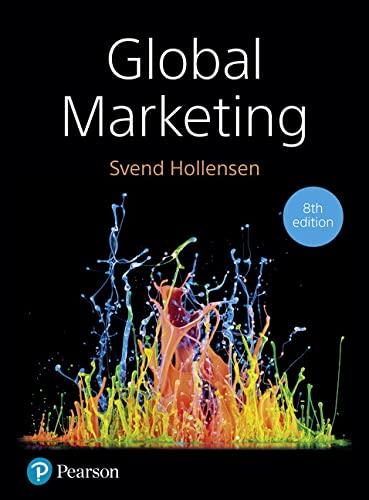William Demant (earlier Oticon) is a leading worldwide manufacturer of hearing aids. The company operates in a
Question:
William Demant (earlier Oticon) is a leading worldwide manufacturer of hearing aids. The company operates in a global market with subsidiaries in more than 30 countries, has a staff exceeding 12,000 and generates annual revenues of DKK 13 billion (2017).
Their products and services are sold in 130 countries.
Background A hearing loss rarely happens overnight. Most often, it happens over time and gradually worsens with age. Thus, realizing a hearing loss also takes time, and once realized, the process of doing something about it begins. Several reasons make this a lengthy period as well. The hearing impaired may not be fully aware of the severity of the problem and what a hearing aid could do for them. Also, the process of getting a hearing aid and learning to live with it is believed to be troublesome. In turn, this puts a constraint on innovative product launches’ effectiveness in attracting new customers as this is to a large degree an unawareness problem.
Wearing a hearing aid has long been associated with disability and old age for the user. This is especially a problem for the younger segments. Hearing aid manufacturers have tried to solve the problem by designing smaller products, ultimately aiming for invisibility. Another solution is integrating technology into the products that not only helps people regain their hearing, but also provides them with value in other ways, such as letting users stream music, or talk on the phone directly through the hearing aid.
Hearing aids give back the hearing ability to people with hearing losses. A hearing aid has three basic parts: a microphone, amplifier, and speaker. The hearing aid receives sounds through a microphone, which converts the sound waves to electrical signals and transmits them to an amplifier. The amplifier increases the power of the signals and then sends them to the ear through a speaker.
Although many sub-categories exist, hearing aids are generally classified under two main categories:
Behind the Ear (BTE) and In the Ear (ITE), which describe where the hearing aid is placed. Today, around 80 per cent of hearing aids sold are in the BTE category. Many with hearing loss start out in this category because BTE hearing aids are more powerful and can adjusted when the hearing problem gets worse.
With connectivity, companies now offer a growing amount of smartphone applications. Furthermore, some companies have even experimented with remote hearing aid fitting. By connecting with the audiologist through the smartphone, users could be fitted with their hearing aids, while sitting comfortably at home. In turn, this would mean that companies could sell products online, as potential consumers would no longer have to pay the audiologist a physical visit. Finally, the research providers speculate in the usage of the memory of the hearing aids; big data could prove useful in revealing usage patterns of the hearing aid.
There are different factors affecting a person’s hearing ability: the intentional use of loud music and external factors such as traffic, noise at institutions and schools, as well as health-related issues such as allergies and diabetes. Despite this, hearing loss is most commonly associated with aging. As Figure 1 suggests, hearing loss is significantly more pronounced in the elderly segments of the population.
In fact, more than one-third of people at retiring age are affected by hearing loss.....
Questions
1. Explain consumer buying behaviour in connection with the purchase of hearing aids.
2. Prepare a SWOT analysis for William Demant.
3. How should William Demant utilize the partnership with Philips in a ‘value net’ perspective?
4. Which of the threats are most serious for William Demant and how should they react to them?
Step by Step Answer:






